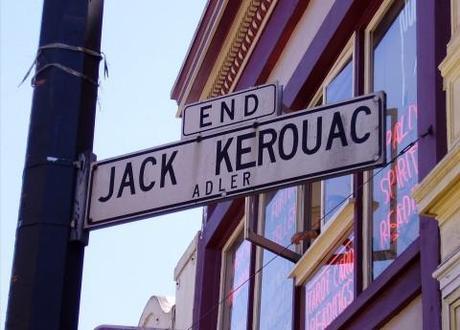
Jack Kerouac's had a lasting influence on American culture. Photocredit: http://www.fotopedia.com/items/flickr-1466941287
The Sea is My Brother tells the story of Jack Kerouac’s experiences in the American merchant navy after he dropped out of Columbia University at the age of 20. Taken almost directly from a journal he kept of the trip, it was unpublished, but found amongst his widow’s possessions in 1992. It has now been published, along with some juvenilia, including letters to his childhood friend, Sebastian Sampas. Kerouac is perhaps best known for his Beat novel, On the Road, which showed drifters in America and was written in “spontaneous” prose.
This novel concerns the friendship between Bill Everhart, a Columbia Universtiy English professor, and Wesley Martin, a 27-year-old traveler who’s spent a decade going back and forth in America. Martin manages to convince Everhart to go with him on the SS Westminster, a merchant ship heading for Greenland; but the plot is, as one would expect, minimal. Critics are fairly divided: some suggest that it’s about time Kerouac was kicked off his pedestal; others say that this novel shows the promise of a future talent. Even if there are some bits that sound a bit, well, like Mills and Boon (see below.) All the usual themes are here: suppressed homoeroticism, travelling, the search for meaning.
Glimpses of genius? It didn’t impress Nicholas Blincoe very much. One wonders how “lost” this novel actually was, he said in The Daily Telegraph.Kerouac caught the minds of a generation with On the Road, his 1957 novel; but he was 35 when it came out, hardly the age to be a youth icon; he was dead 12 years later, having drunk himself to death. “His years traveling in search of enlightenment ended in intertia and depression.” The Sea is My Brother shows that Kerouac developed his obsessions early – “passionate male-on-male friendships”, for one. But whereas the lyrical intensity of On the Road is “other-worldly”, it simply sounds “formal and old-fashioned” in this early book. There are “glimpses” of his later genius, but only glimpses.
“It was a way of life, at sea; it meant equality, sharing, cooperation, and communal peace.” Taken from The Sea is My Brother, quoted in The Sunday Times.
Fizzing with talent. It’s a “slip of a thing”, said Robert Collins in The Sunday Times, who was much more positive about the whole thing; and the sea itself “makes a surprisingly late appearance.” In fact, it’s “anything but a sea novel”, concerning itself mostly with “Everhart and Martin’s stumbling, sozzled progress.” Kerouac is “brimful of idealism” here, and even with its “unbridled naivety”, it’s a “much less grating novel” than On the Road. It’s “more restrained”, and has a “successful balance” between the “free-roaming, beatnik Kerouac” and his precursors that he “consciously” emulates – Herman Melville, Thoreau, Nathaniel Hawthorne, Thomas Wolfe. His “sumptuous descriptions” are “remarkable” for his age. Over time, On the Road seems more and more to fit Truman Capote’s “withering assessment: ‘That’s not writing, it’s typing.’” This book, however, shows that Kerouac was “positively fizzing with talent.”
What makes a writer. Kerouac is immensely prolific, “posthumously”, said David Barnett in The Independent. But of everything that’s appeared, The Sea is My Brother has “the most significance.” In “both style and construction” it shows Kerouac’s “immaturity.” But there are “wonderful bursts of Kerouackian jazz-prose.” But would Kerouac himself have wanted the book to be published? He could have done – but didn’t, apparently calling it “a crock as literature.” The book’s “real value” shows that Kerouac didn’t arrive “fully-formed” as “King of the Beats” – he grew and evolved, just like any great writer should do.
Hmmmm. Really? asked Patrick Skene-Catling in The Spectator, who said that some of it’s “toe-clenching”, quoting a description of a sunrise: “’ In the East now the sun sent forth its pink heralds; a long sash laned to the ship, like a carpet of rose for Neptune.” But it does have value as a “literary curio for anyone interested in the decline of civilization.” The letters between Sebastian Sampas (a poet of “extraordinary awfulness”) and Kerouac also included in the volume show the latter’s “idealistic anarchy.”
At least read the letters. Michael Arditti in The Daily Mail praised the letters, saying they were “a lasting testament both to Sampas’s influence on Kerouac’s work and to his own literary achievement.”
Mills and Boon. Olivia Laing in The New Statesman, however, was much less generous, calling the book “a conflict between brain and brawn” that was “spectacularly tedious.” There’s also “a rich and unattractive seam of misogyny here”, though Kerouac himself sometimes sounds just like Jo March in Little Women and Mills and Boon. The introduction may argue that Wesley and Bill show “two sides of Kerouac’s character”, but it is hard “to know which is more irritating: the self-dramatising student, or the cocky bore of later life whose slovenly influence … lingers in American lives and letters to this day.”

